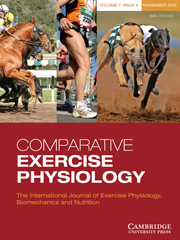Article contents
Heart rates of horses during competitive dressage
Published online by Cambridge University Press: 02 June 2009
Abstract
An understanding of the physiological and metabolic demands of competition is essential for the development of training regimens that elicit adaptations appropriate for the sport being participated in. Despite the fact that dressage is a major sport and one of only three equestrian Olympic disciplines, to date there appear to be no studies that have described the heart rate of horses performing competitive dressage in any detail. The present study was therefore undertaken to describe the physiological demands of dressage competition. Thirty-five horses competing in a total of 50 dressage tests, 36 of which were at British dressage (BD) elementary level and 14 at BD medium level, were studied. The horses studied were predominantly Warmblood or Thoroughbred cross geldings with an age range from 6 to 17 (mean ± SD age of 10.0 ± 2.5 years). The average durations of warm-up for all horses competing were 31.3 ± 15.4 min at elementary level (n = 36) and 31.4 ± 10.0 min at medium level (n = 14; P>0.05). The mean and mean peak heart rates for horses warming up for elementary level were 91 ± 13 and 146 ± 35 bpm (beats min− 1), respectively, and were not different to that for horses warming up for medium level (mean 91 ± 10 bpm; peak: 144 ± 32 bpm; P>0.05). The mean and mean peak heart rates for all horses while competing at elementary level (n = 36) were 102 ± 13 and 132 ± 20 bpm, respectively, and 107 ± 8 and 132 ± 10 bpm, respectively, for medium level (n = 14), and were not significantly different (P>0.05). Mean heart rates during competition were significantly higher compared with that during warm-up for both elementary and medium levels (P < 0.001). Mean heart rate during competition (elementary and medium data combined) was significantly correlated with mean heart rate during warm-up (r2 = 0.503; n = 50; P < 0.001). There was no association between heart rate, warm-up duration and score or placing. These observations suggest that competitive dressage at BD elementary and medium levels is only moderately aerobically demanding.
- Type
- Research Paper
- Information
- Copyright
- Copyright © Cambridge University Press 2009
Footnotes
Present address: English Institute of Sport, Coleridge Road, Sheffield, Yorkshire S9 5DA, UK.
References
- 14
- Cited by


